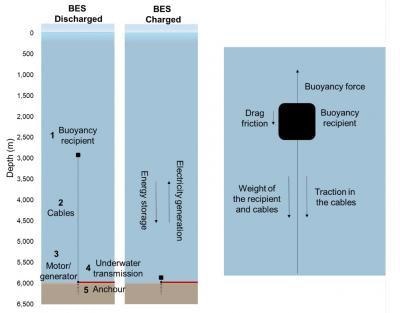Jun 24 2021
Pipes and anchors may play a more significant role in storing energy that could never have been imagined before. A new study, headed by the International Institute for Applied Systems Analysis (IIASA), has investigated the potential of a less familiar but viable sustainable energy storage system, known as Buoyancy Energy Storage.
 Buoyancy Energy Storage, (a) the system and main components and (b) forces exerted in the buoyancy recipient. Image Credit: Hunt et al. (2021).
Buoyancy Energy Storage, (a) the system and main components and (b) forces exerted in the buoyancy recipient. Image Credit: Hunt et al. (2021).
A general consensus is that renewable energy sources will play a crucial role in assuring a healthier and more sustainable future for Earth and its inhabitants. Several nations have already witnessed how these technologies displace “dirty” fossil fuels in the power industry in an attempt to reduce emissions.
A major concern with renewable energy sources, however, is that the power supply is irregular, which means that the energy output at any specified time does not essentially fulfill the requirement at that time. For example, in the case of solar power generation, electricity generation is highest during the day when there is a low demand for electricity, leading to times of energy excess alternating with times of energy deficit.
A prerequisite for any stable energy system is the balance between energy supply and demand. With regard to the intermittent supply of renewable energy, efficient and reliable ways to preserve energy will be significant to ensure the effective adoption of such technologies.
In the new article recently published in the Journal of Energy Storage, Julian Hunt, an IIASA researcher, and his collaborators investigated one of the less familiar but potentially sustainable energy storage systems, called Buoyancy Energy Storage (BEST)Technology.
Buoyancy Energy Storage Technology (BEST) can be particularly useful to store intermittent energy from offshore wind power plants, especially in coastal regions and small islands. As an added benefit, the same technology can be used to compress hydrogen and transport it underwater.
Julian Hunt, Researcher, International Institute for Applied Systems Analysis
The idea behind the Buoyancy Energy Storage is built on the popular technology of pumped energy storage systems. The system usually includes floating platforms located near offshore wind farms and utilizes a generator/electric motor for preserving energy by reducing a compressed gas recipient.
This generally includes an array of tanks or balloons, located in deep seafloor sites, and electricity is produced by enabling the compressed gas recipient to surge through the water.
Hunt and his collaborators, however, have suggested new components for building a BEST system, like the introduction of a range of high-density polyethylene (HDPE) plastic pipelines organized in a vertical fashion to create a cube, paired with an anchor system linked to the seafloor.
The researchers carried out several simulations to validate their amendments to the system and find out the possibility of storing energy at varying depths of the ocean. The team’s results indicate that if the system is deeper, the volume of the compression gases will vary less with the ocean depth and the system will store a larger amount of energy.
Yet, the investigators also pointed out that deploying the system at a higher depth inexorably comes at a higher price. With that said, the cost of using the BEST system to preserve energy still emerged as lower per megawatt-hour (MWh) when compared to the cost of using traditional battery systems.
While the cost of batteries today is around US$ 150 /MWh, the cost of BEST is just US$ 50 to US$ 100 per MWh. Given that the cost of installed capacity for batteries is smaller than in BEST systems (US$ 4 to US$ 8 million per megawatt), battery and BEST systems could be operated in conjunction to provide energy storage for a coastal city or for an offshore wind power plant.
Julian Hunt, Researcher, International Institute for Applied Systems Analysis
“It is important to also bear in mind that the cost of BEST systems can be significantly reduced if a substantial investment is made in the technology,” Hunt added.
Another significant area where the BEST systems can be used is the compression of hydrogen for transportation and storage purposes. Attempts to decarbonize the global economy have brought a renewed focus to the advantages of an upcoming hydrogen economy. One of the major barriers to a hydrogen economy is the cost associated with compressing and transporting the hydrogen.
The researchers believe that the investment costs involved in compressing hydrogen through the BEST systems are about 30 times lower than they would be using traditional compressors, and the procedure involved would provide an additional advantage of considerably decreasing the energy consumption in compression.
After compressing the hydrogen underwater, it can be preserved in a pressure tank and brought to the surface. Alternatively, it can be supplied to other continents in deep, large underwater pipelines partly filled with sand. The sand will help reduce the floating capacity of the pipeline so that it stays at the intended depth and remains fixed to the base of the ocean with anchors.
Such hydrogen and sand-filled pipelines combined with BEST systems have the potential to become the backbone that sustains the future hydrogen economy, connecting all continents.
Julian Hunt, Researcher, International Institute for Applied Systems Analysis
Journal Reference:
Hunt, J. D., et al. (2021) Buoyancy Energy Storage Technology: An energy storage solution for islands, coastal regions, offshore wind power and hydrogen compression. Journal of Energy Storage. doi.org/10.1016/j.est.2021.102746.